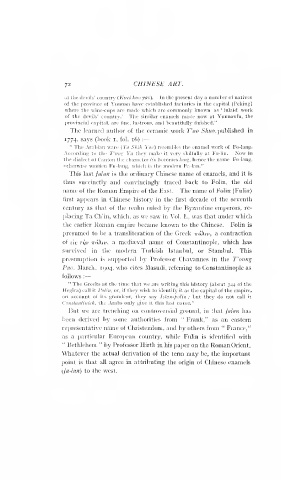Page 248 - Chinese Art, Vol II By Stephen W. Bushell
P. 248
—
72 — CHINESE ART.
of the devils' country (Kuei kuo yao). In the present day a number of natives
of the province of Yunnan have estabhshed factories in the capital (Peking)
where the wine-cups are made which are commonly known as ' inlaid work
of the devils' country.' The similar enamels made now at Yunnanfu, the
provincial capital, are fine, lustrous, and beautifully finished."
The learned author of the ceramic work T'ao Shno, published in
1774, says (book i, fol. 16) :
" The Arabian ware {Ta SJii/t Yno) resembles the enamel work of Fo-lang.
According to the T'ling Ya they make it very skilfully at Fo-lin. Now in
the dialect of Canton the character lin becomes long, hence the name Fo-lang,
otherwise written Fu-lang, which is the modern Fa-lau."
This last falan is the ordinary Chinese name of enamels, and it is
thus succinctly and convincingly traced back to Folin, the old
name of the Roman Empire of the East. The name of Folin (Fulin)
first appears in Chinese history in the first decade of the seventh
century as that of the realm ruled by the Byzantine emperors, re-
placing Ta Ch'in, which, as we saw in Vol. L, was that under which
the earlier Roman empire became known to the Chinese. Folin is
presimied to be a transliteration of the Greek noXtv, a contraction
of £<c T))v TToAir, a mediceval name of Constantinople, which has
survived in the modern Turkish Istanbul, or Stambul. This
presumption is sujiported by Professor Chavannes in the T'oung
Pao, March, 1904, who cites Masudi, referring to Constantinople as
follows :
" The Greeks at the time that we are writing this history (about 344 of the
Hegira) call it Polin, or, if they wish to identify it as the capital of the empire,
on account of its grandeur, they say Istan-polin ; but they do not call it
Constantinieh, the Arabs only give it this last name."
But we are trenching on controversial ground, in that falan has
been derived by some authorities from " Frank," as an eastern
representative name of Christendom, and by others from " France,"
as a particular European country, while Fulin is identified with
" Bethlehem " by Professor Hirth in his paper on the Roman Orient.
Whatever the actual derivation of the term may be, the important
point is that all agree in attributing the origin of Chinese enamels
(fa-lan) to the west.

